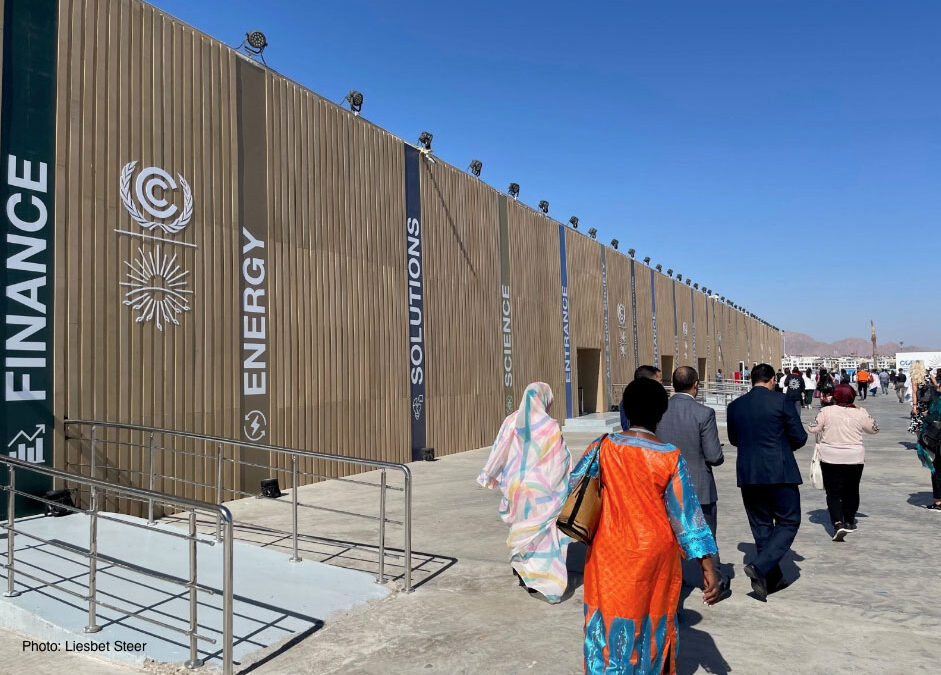Since the closing of this year’s Conference of the Parties (COP27), many have reflected on the achievements and disappointments of the climate summit. The Loss and Damage Fund and strong calls for reform of the international financial architecture were seen as good outcomes of COP27, but the negotiations were broadly assessed as disappointing.
A positive development that has not featured in the many COP27 wrap-ups (with one or two exceptions) is the increased attention paid to much needed investments in education and human capital as critical elements of mitigation and adaptation strategies.
This is significant because we know that people with low levels of education are often most vulnerable to the impacts of climate change, and the least equipped to be part of the climate solution!
We also know that 70% of all young people who are old enough to be economically active do not have the most basic literacy and numeracy skills. That is 840 million young people between the ages of 15 and 24 who will struggle to be part of the solution.
They urgently must become more central to it.
No adaptation, no mitigation without education
Yet education has typically not been a central issue in climate discussions. Discussions often focus on physical and natural capital rather than human capital. The most recent analysis of NDCs shows that only one-third of NDCs mention climate change education and less than 15% mention green skills.
This year’s COP showed this may be changing and momentum has been building in at least three areas:
First, a growing recognition that human capital is required to fuel the transformation of economic systems.
Actions to decarbonize our economies and protect and restore ecosystems will require transformational change across nearly all systems – including energy, transport, the built environment, industry, land use, agriculture, and management of the world’s freshwater and oceans. The Systems Change Lab dashboard traces 70 major system-wide shifts that are required if we are to remain under 1.5 degrees C average warming.
These shifts will require significant skilling and reskilling of existing and future generations of workers. A recent paper highlights the positive relationship between investments in human capital, green technologies, reductions in emissions levels, and reductions in inequality that could result from carbon pricing. There is no just transition without education.
But new approaches are needed. Today most training and, in particular, on-the-job training, focuses on skills directly related to current job-related tasks. Since green jobs require different kinds of tasks than traditional jobs, workers may have difficulty obtaining training in the breadth of green skills needed for the green transition. This will require building other transformative capacities and “soft” skills (e.g., problem solving, collaboration, communication) in addition to job-specific skills. Convincing companies to take on these wider forms of training will require incentives or subsidies from governments.
The IRENA Energy Transition Education Network, launched at COP27, aims to unite governments, intergovernmental organizations, educational and training institutions, professional bodies, and other stakeholders to reskill the current workforce, produce a new generation of energy professionals, and create informed consumers to support the energy transition.
Second, a growing understanding that investing in education is an investment in resilience.
We are already losing the battle against climate change and need to adapt. Adaptation measures in the form of building flood defenses, restoring mangrove swamps, and regrowing forests are recognized as key measures to help countries become more resilient to the impacts of climate change. It is also recognized that poor countries often struggle to gain access to financing for these efforts. This is why maintaining the commitment to double adaptation finance has been seen as a critical achievement.
But a largely missed strategy to build resilience is education. For the first time ever, education was highlighted as a key strategy and cross-cutting theme in the State and Trends of Adaptation 2022 report. The education chapter developed by the Education Commission highlights the strong correlation between countries’ resilience and ability to adapt and their levels of education. Allocating money to education is perhaps the most powerful investment in creating resilience. Education creates flexibility and resilience, both essential ingredients to a prosperous future.
Greater investment in education, especially for girls and women, is a critical means of enhancing adaptive capacities over the long term. It is estimated that there could be a 60% lower death toll from extreme weather events by 2050 if women and girls in sub-Saharan Africa could have a secondary-school education. Women are often closest to many of the key levers for climate-related behavioral changes, such as water usage, farming techniques, and cooking and heating habits. Investments in women’s and girls’ education offer the potential dual benefit of furthering climate action while increasing overall social equity.
Finally, we see increased efforts to promote climate literacy and climate action in school systems.
We know that decades of a “take-make-waste” economy is pushing the earth’s carrying capacity to its breaking point. The way we live and our relationship with our environment starts early in life – with the education we get inside or outside the classroom. By increasing young people’s awareness and understanding of climate change, we can empower them to become agents of change in their own communities.
Apart from building skills and awareness, education systems can also play a direct role in climate action because they are also major hubs for food, transportation, and infrastructure. They can develop green spaces, green transportation, and provide nutritious meals sourced from sustainable sources.
Effective school feeding is among the policies recommended by the Global Panel on Agriculture and Food Systems as it cuts across many parts of the food system, contributes to a nutrition-educated next generation, and generates more and predictable food demand. School meals can also support local agriculture and markets while simultaneously improving health, nutrition, and education, making communities more resilient. School meals can also play a role in the shift towards plant-based diets that are needed to address climate change. Agriculture and its associated land use is responsible for nearly a third of greenhouse gas emissions. This topic was discussed in this Future of Food COP27 podcast and is a key part of the work of the School Meals Coalition.
But is education itself flexible enough for the challenge?
As demand for education and training as a critical ingredient for climate action grows, the question has arisen whether the education sector itself is ready for this challenge.
This year’s Transforming Education Summit underlined the need for the sector to be transformed itself and become more flexible and relevant – but there is a long way to go. Education in most countries remains one of the most unreformed public institutions. Many of its methods and practices were developed for the industrial age and are not fit for a future green economy. The role of the teacher and wider education workforce must be fundamentally redesigned and new technologies need to be harnessed more effectively.
The recently released Rewiring Education for People and Planet report calls for a new partnership between education and other economic sectors, and between the public and the private sector, to ensure skills needs for the climate transition can be met. It calls for us all to come together and work more collaboratively within and across sectors – not something the education sector has been particularly good at doing.
It also highlights the need for additional financing. That must start with governments taking the lead and making bold decisions to increase budget allocations and improve education outcomes. The decision of President Julius Maada Bio and Minister David Sengeh of Sierra Leone to increase investments in education even in hard economic times stands out as an example in this regard.
But domestic spending will not be enough for low- and lower-middle-income countries – and international donors and the private sector must help. In resource-scarce environments this will require mobilizing innovative finance such as the recently launched International Finance Facility for Education (IFFEd) which multiplies every donor dollar seven times. The model is now also being explored for climate finance as highlighted in the report by the Independent High-Level Expert Group on Climate Finance.
The UAE, host of next year’s UN climate change conference, has said it wants to make education a central issue of COP28. This could be a historic opportunity to launch a compelling agenda of win-win solutions for people and planet! Let’s not waste it.

Looking down on the Egyptian landscape as we convened in Sharm El-Sheikh reminded us all what we are up against. Egypt has been warming twice as fast as the rest of the world and the Nile, once the beacon of fertility and civilization, is drying up. There is no time to waste.

